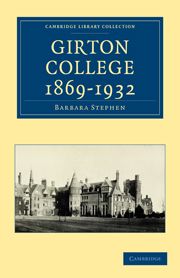Book contents
- Frontmatter
- Contents
- Preface
- Chapter I INTRODUCTION
- Chapter II PRELIMINARY WORK FOR THE COLLEGE
- Chapter III THE COLLEGE IN ITS PIONEER DAYS
- Chapter IV FROM HITCHIN TO GIRTON
- Chapter V GROWTH AND CONSOLIDATION 1875–1903
- Chapter VI A TIME OF TRANSITION 1903–1922
- Chapter VII THE ROYAL COMMISSION AND THE CHARTER
- Chapter VIII THE STATUTES OF 1926, AND THE NEW BUILDINGS
- Chapter IX VARIOUS MATTERS
- Biographical Index
- Index
- Plate section
Chapter I - INTRODUCTION
Published online by Cambridge University Press: 05 July 2011
- Frontmatter
- Contents
- Preface
- Chapter I INTRODUCTION
- Chapter II PRELIMINARY WORK FOR THE COLLEGE
- Chapter III THE COLLEGE IN ITS PIONEER DAYS
- Chapter IV FROM HITCHIN TO GIRTON
- Chapter V GROWTH AND CONSOLIDATION 1875–1903
- Chapter VI A TIME OF TRANSITION 1903–1922
- Chapter VII THE ROYAL COMMISSION AND THE CHARTER
- Chapter VIII THE STATUTES OF 1926, AND THE NEW BUILDINGS
- Chapter IX VARIOUS MATTERS
- Biographical Index
- Index
- Plate section
Summary
Different origins of men's and women's colleges. Women in the nineteenth century. The women's movement and its founders. The founders of Girton. First steps towards higher education.
The women's colleges at the older Universities are now so well established as to be taken for granted as a necessary part of the national system of education. Their character and aims are so far similar to those of the men's Colleges as to obscure at first sight the fact that they are totally different in origin and history. These differences of course leap to the eye so far as the buildings are concerned; and they must be explained if we are to understand their present character and position.
When Girton College was founded in 1869, the University of Cambridge was still in the midst of that remarkable process of change which was to transform its character in the course of the nineteenth century. With five hundred years of life behind it, it was entering upon a fresh chapter and renewing its vitality, after the stagnant period of the eighteenth century, with its sinecures and its narrow exclusiveness.
The origins of the University can be traced back to the thirteenth century; many of the Colleges date from the Middle Ages, and most of them had come into existence before the Reformation.
- Type
- Chapter
- Information
- Girton College 1869–1932 , pp. 1 - 11Publisher: Cambridge University PressPrint publication year: 2010First published in: 1933



